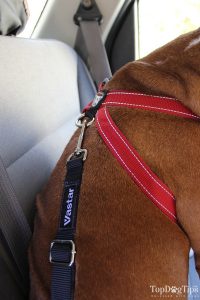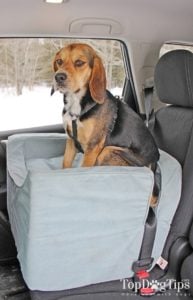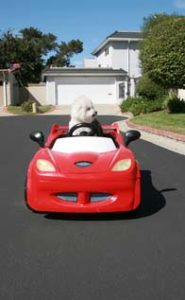
Table of Contents
Whether you are planning a car trip with your pooch or simply going grocery shopping around the block, securing your dog in a car is just as important as it is with kids.
Even though many pet owners ignore this, transporting a dog in a car has to be done correctly.
This isn't just for your dog’s safety but also for your own and the safety of those around.
Here are some essential tips to keep in mind for securing a dog in a car.
Choose a Restraining Option
Since 2009, the government has taken a serious stance regarding the laws on securing animals in moving vehicles.
The laws have been getting stricter, and many states are now imposing new rules about the proper restraint of pets in cars.
For example, New Jersey police officers can fine anyone who is incorrectly transporting a dog in a car.
Some politicians in Denver are also proposing seatbelt laws for dogs.
Many other states have similar laws about improper restraint of pets (sometimes resulting in huge fines), so make sure that your dog is properly secured not only for safety but also according to the laws.
Check this site to see if your dog is legally required to be harnessed in a car. Then, pick the right type of seat belts and/or harnesses for your vehicle.
There are several types of car restraints for dogs available. Depending on the size and temperament of your pooch, choose one of the below and make sure to check your state laws to see if this complies.
Dog Harness Seat Belts
 Fit a dog harness seat belt in your car to restrain your dog. Most of them are suitable for both large and small dogs. However, if you have a young or overly active dog, you should consider attaching a zip line harness to the seat belt instead of a regular dog harness.
Fit a dog harness seat belt in your car to restrain your dog. Most of them are suitable for both large and small dogs. However, if you have a young or overly active dog, you should consider attaching a zip line harness to the seat belt instead of a regular dog harness.
A regular dog harness is more suitable for well-behaved dogs, while a zip line harness allows dogs who have problems settling and need more freedom to move around.
Also, seat belts are not a suitable choice for dogs that are strong chewers unless you choose a chew-proof seat belt made out of steel rope.
Take a look at Samantha's comparison of doggy seat belts here for more explanations.
Travel Dog Crates
Dog crates are a great choice for dogs that are relaxed and comfortable with car rides.
They also have many advantages and can be used for different reasons other than car rides.
There are specifically designed travel dog crates that will attach to your vehicle's seat belts or seats for extra security.
Choose a big enough crate to provide your pooch with enough space to stand or turn around in it.
You also need to have the size of your car in mind when you choose the right crate.
Dog crates are best placed in the back seat or in the boot. Make sure that the crate is securely fastened in one place.
You can also cover the crate with a blanket when you install it – this may help your dog relax and feel more secure.
Make sure that the crate is well-ventilated and practice other security and health measures.
Booster Seats and Carry Boxes
 Small and anxious dogs could benefit most from elevated boxes, better known as dog booster seats. These dog car seats can help your Fido relax by providing a good view of the surroundings and you, the owner. There are different types of dog carry boxes and car seats; some go in the back seat, and some can be attached in the front. They are always used in conjunction with a dog harness since they alone won’t keep your dog secure.
Small and anxious dogs could benefit most from elevated boxes, better known as dog booster seats. These dog car seats can help your Fido relax by providing a good view of the surroundings and you, the owner. There are different types of dog carry boxes and car seats; some go in the back seat, and some can be attached in the front. They are always used in conjunction with a dog harness since they alone won’t keep your dog secure.
Not all dog car seats are secure and safe, however.
Some doggy seats have been crash-tested with bad results, while other brands have claimed to be safe and secure for pets but aren't really.
Read this article on the truth about doggy car seats, their safety, and crash testing.
While there are a number of well-rated car seats for dogs, about 99% of them have never been tested in a car accident.
You need one that will keep your pooch safe if the worst happens.
Hammocks
This option will rarely satisfy laws that require you to restrain your pet in a vehicle, but they can be used in certain situations.
Choose a backseat hammock for dogs if you have an older pooch who might want to lie down. There are a number of good dog car hammocks, some better than others, but none provide enough restraint.
Hammocks should not be a replacement for proper harnessing.
 Generally, a backseat hammock for dogs will protect your Fido from falling off the seat and prevent your pet from spreading mud, dirt, and hair all over your car; you can get specific car seat covers for that, too.
Generally, a backseat hammock for dogs will protect your Fido from falling off the seat and prevent your pet from spreading mud, dirt, and hair all over your car; you can get specific car seat covers for that, too.
It will also stop him from climbing into the front. Consider a dog car hammock that has a non-slip covering to prevent it from sliding off the back seat, too.
Barriers
Dog guards and other barriers are best suited for bigger dogs (and bigger cars) because they allow them to have as much space as they need, either in the back seat or in the boot, while stopping them from being thrown forward if you have to suddenly use brakes.
Once again, this doesn't replace proper restraining of a pet in a moving vehicle and is used mostly for different reasons and owners' convenience.
Prepare for Car Rides
 Many dogs are nervous when they ride the car for the first few times. Some cars even get car sick. If your pet is not accustomed to car rides, give him a few short test drives first, especially if you plan to go on a longer trip later on.
Many dogs are nervous when they ride the car for the first few times. Some cars even get car sick. If your pet is not accustomed to car rides, give him a few short test drives first, especially if you plan to go on a longer trip later on.
Create a positive association with care for your dog. Take him to the car and give him some treats.
Do this a couple of times, and then take him for a test ride.
At first, only take him for a short trip down your street and come back. Increase the length of your trips gradually and stop before your dog shows any anxiety or distress.
Take Him to the Vet
If your dog is often nauseous or suffers from car sickness, general motion sickness, or anxiety, take him to the vet to get appropriate medication.
You can also prevent motion sickness if you feed your dog early, a few hours before you go on a trip.
Even if your dog is usually fine driving in a car, but you plan to go on a longer trip, go to the vet for a checkup before your trip.
Take Regular Breaks
Unless you are going only for a short ride, take breaks often. This will help your pooch to stay calm.
Stop every couple of hours to let your dog run for a while and do his business.
These breaks will be good for both of you, and they will keep your Fido relaxed and tired for car rides.
Don’t Leave Your Dog Alone in the Car
 Never leave your dog alone in the car, especially in high temperatures. Dogs can get very anxious after a while in a car on their own, and even a short time in a car when the temperature is high can lead to a heatstroke. Also, in some places, it is illegal to leave a dog alone in the car.
Never leave your dog alone in the car, especially in high temperatures. Dogs can get very anxious after a while in a car on their own, and even a short time in a car when the temperature is high can lead to a heatstroke. Also, in some places, it is illegal to leave a dog alone in the car.
If you absolutely have to leave your dog alone in the car, check the temperature first.
Remember, the temperature outside is not a good reference since the temperature in the car can get much higher, even up to 30 degrees.
Make sure that your air conditioning is on and working properly in this case.
Beware of the Windows
Don’t let your dog stick his head out of the window. Experts have warned pet owners about this for years, but many owners still allow this.
While there are no laws against it in most states, some police officers will stop cars and warn pet owners.
This can dry his eyes, and foreign objects can hit your dog at high velocity. Some dogs can unexpectedly jump out of the car, and there are plenty of other dangers.
If your car has power windows, your dog could accidentally open them.
This is dangerous, especially if you have a dog that gets easily excited since he can jump out of the moving car.
Your dog could also close the window accidentally while his head is sticking out, which can hurt his neck or even choke him. Keep your power windows turned off.
Car rides are often exciting for dogs, and it is up to you to make sure that your pooch is safe.
These tips can help you secure your dog when you travel with him, regardless of the distance.












